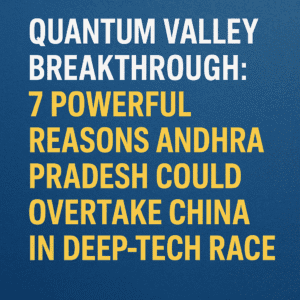Quantum Valley Breakthrough: 7 Powerful Reasons Andhra Pradesh Could Overtake China in Deep-Tech Race
Andhra Pradesh’s pioneering Quantum Valley (launching January 2026) marks India’s strategic bid for global tech leadership. This 50-acre Amaravati hub uniquely converges quantum computing, AI, semiconductors, and defense innovation under one roof—IBM will install India’s most powerful quantum system (156 qubits), while TCS and L&T drive applications and infrastructure. Crucially, state universities are already rolling out quantum degree programs to address the talent shortage threatening such projects globally.
The hub’s renewable-powered design tackles quantum computing’s massive energy demands through mandatory solar infrastructure and smart utilities. Beyond research, it aims to generate patents, high-end jobs, and India’s first quantum governance framework. If successful, this ecosystem could position India as Asia’s quantum nexus, reducing reliance on foreign tech while pioneering sustainable deep-tech infrastructure. Its ultimate test: translating ambition into commercial and strategic breakthroughs by the 2030s.

Quantum Valley Breakthrough: 7 Powerful Reasons Andhra Pradesh Could Overtake China in Deep-Tech Race
While the announcement of Andhra Pradesh’s 50-acre “Quantum Valley” (targeting January 2026) marks a milestone, its true significance lies in three strategic ambitions that could redefine India’s technological future:
1. Beyond Computing: A “Full-Stack” Ecosystem
Unlike isolated research labs, Amaravati integrates quantum computing (IBM’s 156-qubit System Two), semiconductor R&D, AI, and defense innovation under one roof. This convergence mirrors models like Switzerland’s “Quantum Basel” but adds a critical layer: applied industry solutions via TCS and infrastructure scale through L&T. The goal? To transition India from quantum theory to commercializable patents and homegrown hardware—addressing a key gap in the National Quantum Mission.
2. Talent Before Tech: The Education Imperative
The project’s most urgent signal: Andhra University and state colleges are already launching quantum degree programs (2025–26). This reveals a harsh reality: Quantum’s bottleneck is human capital. Without trained engineers and researchers, even cutting-edge hardware gathers dust. By mandating curriculum shifts before the hub’s launch, Andhra Pradesh acknowledges that winning the quantum race starts in classrooms.
3. Sustainability as Infrastructure
Amaravati’s vision to be “renewable-powered” (solar rooftops, EV networks, zero-waste systems) isn’t just green PR—it’s operational pragmatism. Quantum computers require massive energy and precision cooling. Distributed renewables and district cooling could solve this while aligning with India’s climate goals. This synergy between deep tech and sustainable design sets a global precedent.
Unanswered Questions & Risks
(Critical Context for Observers)
- Can India Compete Globally?
- With China investing $15B in quantum and the U.S. allocating $3.7B, Amaravati’s success hinges on sustained funding beyond initial partnerships. Will private capital fill gaps if political priorities shift?
- The “Valley” Dilemma:
True innovation thrives in open ecosystems. Can rigid defense research coexist with academic freedom and startup agility? Governance frameworks must balance security with collaboration.
- Beyond Hype:
Quantum’s near-term applications (material science, drug discovery) lack the visibility of AI. Public and investor patience will be tested before economic returns materialize.
Why This Matters for India’s Future
Amaravati isn’t just a tech park—it’s a litmus test for India’s deep-tech ambitions. If successful, it could:
✅ Position India as Asia’s quantum nexus against China/Singapore.
✅ Create “spin-off” industries in photonics, cryptography, and semiconductors.
✅ Prove that emerging economies can lead—not follow—in frontier technologies.
As Pradyumna (CM Naidu’s aide) stressed: “Telugu people must not miss this opportunity.” The same applies to India. The real story isn’t the 2026 launch—it’s whether India can build a quantum-literate workforce and cross-sectoral agility fast enough to capitalize on it.
You must be logged in to post a comment.